|
[Front Page] [Features] [Departments] [Society Home] [Subscribe]

Electronic Mailbox
 
The following have been selected from the questions received on the ASGAP World Wide web site over the past few months. You're welcome to comment on any issue concerning Australian native plants....growing, propagating or appreciating (even loathing!) ... anything.
If necessary, bung a message in a bottle if your net connection goes down!!

Propagating Lots of Lilly-pillies
We live on a 5 hectare property and are wanting to grow a screen hedge along the boundary fences to block out the dust from a horse training track on the neighbouring property. After seeking advice on the best plant for our purpose we have decided on the lilly pilly, Syzygium australe "Aussie Compact", as it is going to give us the height and density that we require.
As we are going to need in the region of 300-350 plants in total, it will end up being a costly venture if we were to buy all these plants. Therefor we are hoping to try growing them from cuttings from mature trees but are not sure how easy or difficult this will prove to be. I would like to know if a glass house is necessary or if a plastic bag over a wire frame is sufficient. Once they are in their containers do you still need to water them? If so how often should this be done?
I would also like advice on the best way to plant them out as the soil here is heavy clay with shale. We have placed mulch in an attempt to help break down the clay but should we plant directly into the clay or make raised beds? Any relevant advice for a virtual beginner would be greatly appreciated.
M K
Brisbane, Queensland
Syzygium australe usually strikes quite well from cuttings - you don't need a glass house; there are lots of ways of providing the right conditions for striking cuttings fairly cheaply. You will find some suggested methods and general tips on growing plants from cuttings on our web site
The only problem is that cuttings strike quicker in the warmer months and it's getting a bit late in the season now, although Brisbane would be better than Sydney (where I live). Assuming you place the cuttings straight away, you are probably not going to see any roots until spring and, after hardening and potting on, you are probably looking at late summer/autumn next year for planting.
Regarding planting - Syzygium australe is pretty hardy and can handle clay as long as it isn't waterlogged. I would think they should go OK if planted into the clay provide it is well broken up around the plant to allow the roots to penetrate. However, I'm not familiar with your local area and, if you're going to invest a good deal of time and effort, you might consider seeking advice from the local Agriculture or Forestry offices.

Viability of Callistemon Seeds
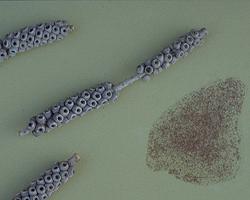
|
|
| Callistemon seed pods and masses of fine seeds |
|
I have obtained a suppy of Callistemon rigidus seeds from Nindethana Seed Service in Albany, Western Australia. The seeds are in a small plastic packet that must have a couple hundred of the very fine seeds. However, I am not yet ready to sow the seeds and need to store them for a month or so because here in West Vancouver, British Columbia spring hasn't arrived yet and it is colder than usual. I don't have a greenhouse and it has been rainy and cold. It's hard to find a consistently sunny window for the pots even if I planted them now.
What is the best way to store the seeds and in what? (eg. a sealed paper bag?) - I have a cool dry garage about 10 celsius.
Also because the seeds are so tiny what is the best way to sow the and approx how many per 100mm diameter pot?" I found the Callistemon Page helpful for germination techniques.
I would really appreciate any advice you could give.
M B
Britsh Columbia, Canada
You can keep them in the plastic bag that they arrived in - Callistemon seeds remain viable for a long time and I've stored seeds in plastic bags for years without problems. Room temperature is fine.
When sowing just take a small pinch of seeds and sprinkle them lightly over the surface of the mix - they don't need to be covered - just spray the surface with a hand sprayer to compact them into the surface. You should get quite a lot of seedlings.

Looking for Sturt's Desert Rose
Hello Down Under!
 |
| Click for a larger image |
I hope you can help me. I have been looking for a source for a Gossypium sturtianum. I understand its also called Stuart's Desert Rose. I am sure I grew up with one in my backyard but I've never seen one anywhere else since then, except in a plant book! I live in South Florida and the plant seemed to do well here. It looked like a lavender hibiscus with a redish center and had a whitish stamen.
I really hope to include one in my own garden, and any help you can give me will be greatly appreciated!
L C
Florida, USA
It's actually called Sturt's (not Stuart's) Desert Rose - but even lots of Australians get that wrong!
I don't know where you would get a plant in Florida but seed should be easy to obtain and it germinates easily. Many of the suppliers listed on our web site would stock it - there are several with email addresses that you could try first.

Looking for Flannel Flower Seeds
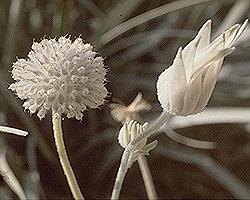
|
|
| Clusters of flannel flower seeds |
|
Hello over there!
I have fallen in love with flannel flowers from a photo in the Thompson and Morgan seed catalog, but when I ordered four packets, I was told they could not supply due to crop failure. One of the sites I visited said it's hard to grow and that seed may have to be very fresh.
HELP! Could you put me in touch with a seed source or a publication that would help me get started? I'd appreciate any pointers at all.
A G
Oregon USA
Seeds of flannel flowers (Actinotus helianthi) should be available from many commercial suppliers - take a look at the list on our web site.
Flannel flowers are very unreliable in germination even from fresh seeds - there are some brief notes on the species on our web site that might help.

A Problematic Pandorea
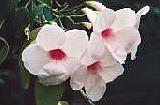 |
| Click for a larger image |
I have a Pandorea jasminoides growing on my garage wall. I put it in about 18 minths ago and it was growing well untill last winter when it began to loose all it leaves. After a short time it dropped all the leaves and I thought I had lost it. A few months ago just when I was thinking about pulling it out it started shooting again and is now covered in flowers. I was wondering if it may do it again, could it be wet feet? I don't feed it at all, should I?
W J
Australia
It's difficult to be sure of the problem.
P.jasminoides grows naturally in warm districts - rainforests and wet sclerophyll forests of north-east New South Wales and south-east Queensland. It can be damaged by frosts in colder areas and this would cause leaves to fall. It also prefers reasonably drained, moist soils but continually wet soils could also cause the problem. I'm not sure where in Australia you are located but, if you are in a cold climate, this could be part of the problem
Could it do it again?? Probably. It sounds like the problem is related to climate or soils (or both) so leaf fall may re-occur because it will be difficult to change either of these conditions.
Feeding is not critical but it should certainly respond to slow release fertilisers and this may help the root system cope with any future wet conditions. I wouldn't be feeding now (coming into winter) as this would stimulate soft, easily damaged foliage. Probably spring would be the best time.

Planting in a Cold Climate
I have recently moved to Bendemeer, New South Wales. Although I love living here, the weather is very, very cold in winter (minus 7o C) and I would appreciate any information on what flowers, plants etc, would survive such a cold climate.
A H
Bendemeer, New South Wales
I don't have lists of frost tolerant plants available but you should be able to get useful information from the web site of the Society's Canberra Region. They have a database of plants suited to Canberra's climate and I would expect that many of these would be suitable in your area.
A back issue of Australian Plants online also has an article on frost tolerant grevilleas that could be useful.

Goldfields Burl
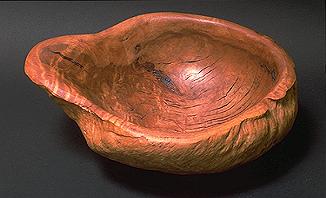
|
|
| A decorative bowl made from a "burl" |
|
I have a piece of what was sold to me as goldfields burl. I have since learned that this is a generic name for any of several different pieces of wood. It is extremely dense and hard with a chocolate brown color.
Any help in identifying it would be greatly appreciated.
J D
USA
I can't really help in exact identification. As you say, "goldfields burl" is a generic name and yours could be one of several species.
Here's one website that might help.....

Grevillea Info
We've recently purchased a Grevillea 'Holsworthy Diffusa' and we would like information about its habit. How big will it get? Were should we plant it? etc.
We'd appreciate any information.
J L
Sydney, Australia
It's proper name is Grevillea diffusa "Holsworthy". G.diffusa is a very variable plant and the "Holsworthy" form was selected for its ornamental foliage and deep red flowers.
It is a small shrub probably reaching 0.5 metres high and wide - under really good conditions it might get to 1 metre. It has red "spider" flowers mainly in winter and spring.
It's probably best in full sun to light shade in a well drained, moist location - it won't succeed in constantly wet conditions.

Medicinal Properties of Australian Plants
I'm currently working on a thesis. My choice of subject is the healing and medicinal qualities of Australian plants, and the original Aboriginal uses of these plants.
I would be very grateful if you could recommend some web sites where I can collect information on this and any related subjects.
J K
Australia
I'm not aware of many specific web sites, however there are links to Bush Tucker sites on our web site.
There are also a couple of articles in back issues of our internet magazine "Australian Plants online".....
The following two pages are from the web site of the Australian National Botanic Gardens....
I hope these help.

A Sick Eucalypt
I hope you can help.
I live in Sydney and have a young eucalypt in my garden (about 3-4 years old). There were two but the other died and I fear this one may be suffering from the same disease.
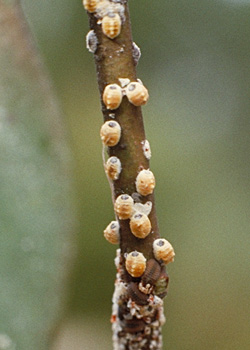
|
|
| Scale insects are often associated with sooty mould |
|
It is starting to develop black patches on its branches, which form into bulbis-like shapes. On the leaves it's like a soot and seems to trickle down the trunk. About a month ago we noticed a lot of ants running up and down the tree; we've got rid of these but the black looks like it's continuing. I really want to do something before it's too late.
Do you know what this disease is? Can we save our tree, or do you know who I could call to look at the tree.
I hope you can help.
L
Naremburn, New South Wales
It sounds like "sooty mould" which is commonly associated with scale infestations - the scale insects exude a sugary secretion on which the mould develops. It is common to see ants associated with scale and sooty mould.
The sooty mould is not the problem - it is the scale that needs treatment. You should be able to observe clusters of small, usually white, waxy shells. These shells conceal the scale insects and protect them from predators. Unfortunately they also protect them from common insecticides so the usual treatment is to spray with "white oil" (available from nurseries). The white oil basically smothers the insects. Several applications may be needed.
If the scale infestation is not extensive and is reachable, you can scrape the "shells" off by hand.
I hope this helps.

Eriostemon and Philotheca Differences
I should be grateful if you would send me some informations or articles about difference with Eriostemon and Philotheca. Thank you in advance looking forward to hearing from you soon.
AC
France
Most of the species in Eriostemon have been transferred to Philotheca. There are now only two species remaining in Eriostemon - Eriostemon australasius and E.banksii.
The article "A Name Changes for Most Eriostemons", from the March 1999 issue of Australian Plants online, should help to explain the differences between the two genera.
In brief, studies have indicated that E.australasius and E.banksii are distinctly different from other species previously classified under Eriostemon and, as E.australasius was the first of the eriostemons to be named (ie. it is the "type" species for the genus), those two species must remain in Eriostemon and the remainder classified differently. As those other species seem to have a relationship with members of the genus Philotheca, they have been reclassified to that genus, at least for now.

Lilly Pilly - Not So Compact?
I hope someone can advise me.
I collected seeds from the lilly pilly aussie compact and planted them in a seed raising mix. The seedlings are now around 2 inches high. Some one told me that the seedlings will not be compacts as you can only grow them from cuttings. Is this true? If so, what are they? How tall will they grow?
Mary
Australia
Yes, it's true that to be sure of getting plants that retain the compact habit of the parent plant, you need to grow them from cuttings.
This is all about genetics (and I'm no expert!). Basically, plants grown from seed have high genetic diversity and because of this genetic mix within seedlings, plants grown from seed will often show a significant variation from the parent. This is not just true of the lilly pilly - it applies to most plants and it's the reason that seedlings of the red flowering gum can produce white or pink flowers. It's very rare that all seedlings in a batch will have exactly the same growth characteristics.
When plants are grown from cuttings they are, in effect, being cloned and they will retain the genetic composition of the parent plant including physical characteristics such as flower colour and growth habit (occasionally there may be a spontaneous mutation, or "sport" which results in a different genetic composition, but this is rare).
The compact form of the lilly pilly was selected from a batch of seedlings because it exhibited the low growth characteristics which are desirable for gardens. However, the seeds that the plant produces will still have the high genetic diversity and will probably not produce plants that retain the compact habit (they might....but there's no way to be sure).
How tall will they grow? There's no way of knowing. All that can be said is that they are likely to be taller than the compact variety because the normal form of the plant is taller.

What's the Story?
Are you able to tell me the origin of the name of Eucalyptus kruseana, also known as Kruse's mallee. I would like to know if this plant is named after the famous Tom Kruse who did the mail run along the Birdsville Track or the chemist called Kruse who worked with Eucalyptus oil in the 1800s.
J M
Melbourne
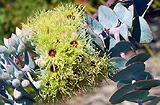 |
Photo: Jim Barrow
Click for a larger image |
According to my references, E.kruseana is named after John Kruse, a 19th century pharmacist and chemist from Victoria. I'm not sure if this is the chemist that you mention but it probably is the same one.
E.kruseana is an attractive small tree with a lot of ornamental characteristics - colourful flowers as well as an attractive trunk and beautiful grey, rounded foliage. It occurs naturally in south Western Australia and is rare in its natural habitat.

Germination Problems
Last year on a trip to Australia, I purchased several packages of seeds, intending to start them in seed flats and plant them at my house. I've had trouble germinating some of them, and in particular the waratah and the Western Australian Christmas tree. Any suggestions?
G R
Virginia USA
You will find general info on propagation from seed on our web site.
The Waratah (Telopea speciosissima) generally germinates readily without any pretreatment and there are no specific "tricks" that I can suggest. It may be that the seed is not viable but sometimes germination can take some time, so I wouldn't give up yet.
The WA Christmas Tree is another matter. Again, there are no "tricks" to promote germination but it is going to be very difficult to raise this plant successfully even if germination is successful. The problem is that it's a root parasite and requires a host species to grow successfully.
There are a number of pages on our web site that may help you with these two plants:

[Front Page] [Features] [Departments] [Society Home] [Subscribe]
Australian Plants online - June 2002
Association of Societies for Growing Australian Plants
|